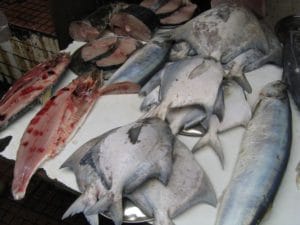New York Times
By Elisabeth Rosenthal

Fish is frequently misidentified on menus and grocery store counters in New York City, even at expensive restaurants and specialty shops, DNA testing for a new study found. National supermarket chains had the best record for accuracy in seafood labeling, the researchers reported.
The researchers, from the conservation group Oceana, said that genetic analyses showed that 39 percent of nearly 150 samples of fresh seafood collected from 81 establishments in the city this summer were mislabeled. The study did not identify any of the restaurants or stores, although it noted that most were in Manhattan.
In some cases, cheaper types of fish were substituted for expensive species. In others, fish that consumers have been urged to avoid because stocks are depleted, putting the species or a fishery at risk, was identified as a type of fish that is not threatened. Although such mislabeling violates laws protecting consumers, it is hard to detect.
Some of the findings present public health concerns. Thirteen types of fish, including tilapia and tilefish, were falsely identified as red snapper. Tilefish contains such high mercury levels that the federal Food and Drug Administration advises women who are pregnant or nursing and young children not to eat it.
Ninety-four percent of fish sold as white tuna was not tuna at all but in many cases a fish known as snake mackerel, or escolar, which contains a toxin that can cause severe diarrhea if more than a few ounces of meat are ingested.
“There are a lot of flummoxed people out there who are trying to buy fish carefully and trying to shop their conscience, but they can’t if this kind of fraud is happening,” said Kimberly Warner, a senior scientist at Oceana, who led the study.
She said that Oceana’s study might underestimate the prevalence of the problem because researchers primarily solicited samples by asking its New York-area supporters to send in tiny slices of the fish they were eating.
Andrew Moesel, a spokesman for the New York State Restaurant Association, said that restaurants were victims, too, when it came to fish fraud. “Restaurants would be very concerned that a high percentage of fish are not what they had ordered,” he said. “Unless you’re very sophisticated, you may not be able to tell the difference between certain species of fish when you receive them.”
Seafood is increasingly sold on a global market with a long and complicated supply chain. Experts suggest that much of the mislabeling occurs at sea or where distributors cut up a fish hundreds to thousands of miles away, making a filet’s provenance hard to verify.
But Abigail Lootens, a spokeswoman for the New York City Department of Consumer Affairs, said that stores could nonetheless be held accountable, adding, “Retailers are under an obligation to correctly identify and label what they sell,” she said.
The Food and Drug Administration, which is charged with ensuring food safety and setting labeling standards, has been working to curb seafood fraud in recent years, developing new programs to combat such fraud in the past year. It has outfitted its field labs with DNA sequencing equipment and has collected hundreds of fillets from wholesalers for testing to determine the frequency of mislabeling and where to aim enforcement efforts.
Among the 142 samples collected, tuna and snapper were the most commonly mislabeled fishes, the Oceana study said. Instances of mislabeling were found in samples from all 16 sushi restaurants from which tested fish was obtained.
The findings are broadly similar to those of studies Oceana has conducted in Los Angeles, Boston and Miami, where 55, 48 and 31 percent of samples, respectively, were mislabeled.
One finding that surprised the research team was that national chain supermarkets offered less mislabeled seafood than regional chains or small specialty markets. High prices were no guarantee of accurate labeling: one restaurant in the highest price range offered red snapper on its menu but, according to Oceana, was serving up lowly tilapia.

